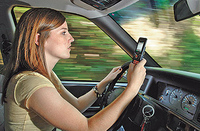Most Drivers With Cell Phones Use Them While Driving Even Though They Know It Is Unsafe
More Than One In Five Text While Driving
NEW YORK, N.Y. Three out of five (60%) drivers with cell phones use them while driving even though almost all adults (91%) know it is unsafe to do so. This is particularly common among younger drivers with cell phones. In addition more than one in five (22%) drivers with cell phones send or read text messages while driving. However the percentage of drivers with cell phones who use them while driving has fallen over the last two years, from 72% in 2009 to 60% now. And, the numbers who text while driving has fallen a little from 27% to 22%.
Several studies have shown that drivers who use cell phones while driving are much more likely to be involved with accidents, and it is believed that texting is even more dangerous. Recent research has shown that both hand held and hands-free cell phones are almost equally dangerous because they are equally likely to distract drivers. However, more than three quarters (77%) of the public believe that hands-free phones are safer.
These are some of the results of The Harris Poll of 2,163 adults surveyed online between June 13 and 20, 2011 by Harris Interactive.
Other interesting findings of this survey include:
- There are big generational differences. The younger age groups, Echo Boomers, aged 18-34 (72%) and Gen Xers, aged 35-46 (69%) are more likely to use cell phones while driving than Baby Boomers, aged 47-65 (59%), and much more likely than drivers over 65 (32%) to do so;
- The Lake Wobegon effect ("where all the children are above average") is alive and well. Most (57%) drivers rate themselves as better than average drivers. Only 1% rate themselves as worse than average. Men (66%) are much more likely than women (48%) to think that they are better than average drivers;
- Texting while driving is also much more common among younger drivers. Fully 49% of drivers with cell phones under 35 send or read text messages while driving compared to only 24% of Gen X, 11% of Baby Boomers and less than 1% of people over 65;
- Most (60%) drivers who use cell phones while driving use hand-held phones. This number has declined from 72% in 2006 and 66% in 2009;
- The large majority who know that it is dangerous to use a cell phone while driving has increased from 82% in 2006 to 91% now; and,
- The percentage of the public who live in states that require (or, which they believe, require) the use of hands-free phones has increased from 14% in 2006 to 38% now.
The implications of these findings point to several important conclusions:
Most drivers with cell phones are behaving in ways (talking on cell phones and/or reading or sending texts) that greatly increase the likelihood that they will be involved in accidents, and injure themselves and others. Furthermore, many of them believe, probably wrongly, that if they use hands-free phones they are safer. The problem may be made worse by the fact that most drivers think they are better than average drivers and, perhaps, that their driving skills can keep them out of trouble.
These findings strongly suggest the need for laws to ban all cell phone use and texting while driving, including the use of hands-free phones, except perhaps in emergencies.
Harris Interactive is one of the world's leading custom market research firms, leveraging research, technology, and business acumen to transform relevant insight into actionable foresight. Known widely for the Harris Poll and for pioneering innovative research methodologies, Harris offers expertise in a wide range of industries including healthcare, technology, public affairs, energy, telecommunications, financial services, insurance, media, retail, restaurant, and consumer package goods. Serving clients in over 215 countries and territories through our North American, European, and Asian offices and a network of independent market research firms, Harris specializes in delivering research solutions that help us - and our clients - stay ahead of what's next. For more information, please visit www.harrisinteractive.com.



